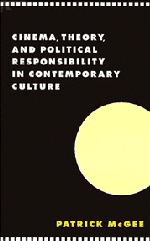Book contents
- Frontmatter
- Contents
- Preface
- Acknowledgments
- List of abbreviations
- 1 Redeeming contradictions: from critical theory to cultural studies
- 2 Art as the absolute commodity: the inter-subjectivity of mimesis in Adorno's Aesthetic Theory
- 3 Sexual nations: history and the division of hope in The Crying Game
- 4 Deconstruction and responsibility: the question of freedom in the place of the undecidable
- Bibliography
- Index
2 - Art as the absolute commodity: the inter-subjectivity of mimesis in Adorno's Aesthetic Theory
Published online by Cambridge University Press: 06 July 2010
- Frontmatter
- Contents
- Preface
- Acknowledgments
- List of abbreviations
- 1 Redeeming contradictions: from critical theory to cultural studies
- 2 Art as the absolute commodity: the inter-subjectivity of mimesis in Adorno's Aesthetic Theory
- 3 Sexual nations: history and the division of hope in The Crying Game
- 4 Deconstruction and responsibility: the question of freedom in the place of the undecidable
- Bibliography
- Index
Summary
True art challenges its own essence.
Adorno, Aesthetic TheoryThe aesthetic thing
The true work of art is never politically correct.
Such a statement is not meant to comfort or support the neoconservative critic in higher education today who makes it his or her business to reduce the unmanageable and sometimes irresponsible power of art to some sort of apolitical pap for nourishing the illusions of the status quo. Such an institutionalized art reinforces the belief in a transparent social reality by insisting on the absolute difference between art and life. Reality, it says, is concrete and particular, while art is abstract and universal. No one worships at the altar of the universal with greater show of devotion than the traditionalist; but at the same time the traditionalist secretly laughs at the intellectual Don Quixote who imagines that those things which are universal have anything to do with the way people are required to live in a world that was not constructed to be a work of art. Art, says the traditionalist, is contemplative and useless – a sort of second thought about the course of history after it is no longer possible to do anything about it.
- Type
- Chapter
- Information
- Publisher: Cambridge University PressPrint publication year: 1997

